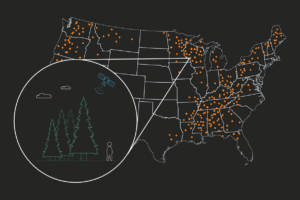As we enter 2025, private landowners are presented with both remarkable opportunities and significant threats. From the expansion of new markets to uncertainty caused by economic shifts, landowners have major decisions to make this year. This blog post outlines the biggest opportunities and threats for landowners in 2025. At NCX, our goal is to arm landowners with the tools and insights they need to make the right decisions for their land.
Opportunities
Program Stacking: As increasingly diverse income opportunities emerge for private landowners, many are taking advantage of “stacking” to maximize returns and reduce costs. Stacking involves engaging multiple opportunities on the same acre at the same time. For example, a landowner might decide to enroll part of their property in a forest carbon project that requires that they let their trees grow for a minimum of 20 years. They then can “stack” opportunities like recreational leasing for hunting, camping, or hiking on the same parcel. This approach can help increase short-term income while growing the long-term value of the land. Landowners with diverse land cover types may also choose to enroll in different programs on different areas of their property. Mitigation banking on the wetlands, grazing on the pasture, forest carbon on the woods. You get the picture. NCX can help you create a plan that outlines the best “stack” for your land based on your eligibility and goals.
Putting Unforested Acres to Work: There are many income opportunities available for unforested parcels like fields, fallow agricultural land, and degraded land. For example, there are a number of carbon programs that pay for reforestation of native tree species. Some programs even cover 100% of the costs of site prep, planting, and maintenance. Other landowners who still want to produce crops may decide to lease to another farmer who doesn’t have their own property or to implement an agroforestry system on the land. While transitioning to an agroforestry system requires up-front investment, it can provide attractive returns as the trees produce fruit and nut crops. For a subset of landowners who have the right type of powerlines near their properties, solar leasing can provide attractive payments, sometimes reaching thousands of dollars per acre per year. Certain crops can thrive underneath solar panels as well, presenting an interesting “stacking” opportunity. With so much opportunity, there are major trade-offs to consider for each of these options. NCX can help you make a plan that aligns with your goals to ensure you’re making the right choice for the future of your land.
Emerging Market Expansion: The days of carbon programs only being for large landowners with thousands of acres of forest are behind us. There are now carbon programs for all different types of land including grasslands, row crops, recently harvested stands, urban forests, and fallow agricultural land. Actions like rotational grazing, that ranchers have been using for generations, now have additional financial incentives tied to increases in soil carbon. Forest carbon programs continue to expand into new geographies as well, increasing the number and variety of options available to forest landowners. There are also a few early-stage pilot programs to pay for biodiversity and wildlife habitat. While these are still young and their availability is limited, 2025 will be an important year to develop proofs-of-concept for biodiversity programs and the land leasing agreements that support them. Each of these opportunities has its own unique requirements, obligations, earnings, and penalties. NCX can help you compare programs to decide which is right for you.
Threats
Economic Uncertainty: The Farm Bill expired in September 2024. In the interim, Congress passed a one-year extension of the 2018 Farm Bill to keep critical agricultural programs afloat while they work through the details of the larger bill. The delay has created uncertainty for landowners, particularly regarding disaster relief, crop-specific subsidies, and popular programs like the Conservation Reserve Program (CRP), which are unable to enroll new applicants until the new bill passes. Shifting national priorities and budget cuts may affect the size and availability of certain programs administered by the USDA. If Congress does not reach a resolution by December 20th, 2024, they’ll have to pick up discussions in the new year. The progress and content of the Farm Bill will be an important issue to track in 2025.
The pulp and paper market, which has been the primary outlet for small diameter trees, will continue to face headwinds in 2025. Shifting demand for traditional paper products and competition from international producers is loosening the demand for pulpwood from private landowners in the US Southeast. These factors combined with an oversupply of small diameter wood in some regions and ongoing mill closures, are reducing stumpage rates for landowners. And that’s if they can get a thinning done at all. As mills close and processing capacity shrinks, transportation costs also increase, which hurts the feasibility of thinning even more. These trends make it harder for landowners to plan harvests and turn their timber assets into cash. On the other hand, companies like Drax Group are investing billions of dollars into Bioenergy with Carbon Capture and Storage (BECCS) facilities throughout the region, which may fundamentally shift the endpoint for small diameter trees from pulp and paper to energy production over the next decade. While there are signs that the US biomass energy market could help ease some of this pressure on small-diameter pine stands in the US South, it’s unclear how soon that impact will be felt. Not sure what your timber is worth and what to do with it? NCX can help you understand your local market conditions and make a plan for harvesting timber at the best possible time.
Natural Disasters: Natural disasters continue to threaten forest landowners, with Hurricanes Helene and Milton in 2024 causing devastation to timber estimated at up to $2.5 billion in damages to forests in the Southeastern US. Hurricane Helene caused an estimated $214 million in damage to timber assets in North Carolina alone.1 Record-breaking wildfires consumed over 8.5 million acres, further devastating forested landscapes, especially in the arid West.2 With fire severity growing, landowners are increasingly paying higher insurance premiums for the structures on their land, if they can acquire insurance at all. As fires and hurricanes damage farms, ranches, and forests throughout the country, not every landowner is equally protected.
Crop insurance administered by the USDA Risk Management Agency does not cover timber assets and there aren’t any widely available private insurance options, leaving forest landowners exposed to losses and reliant on post-disaster programs like the Emergency Forest Restoration Program (EFRP), a cost-share program administered by the USDA. This program does provide important assistance to forest landowners who have experienced disasters, but requires up-front investment by the landowner, is subject to Congressional appropriations, and has per-property limits. There are other policies in flight that might help with this, including the Disaster Reforestation Act, which would update the tax code to allow for landowners to deduct the value of their timber lost to natural disasters. You can get involved by contacting your Members of Congress and telling them about your interest in the bill. The Forest Landowners Association has been leading the charge to advocate for forest landowners with Congress and can help you set up meetings if you need help. If you’ve been affected by a natural disaster, contact NCX at landowners@ncx.com and we’ll help you explore assistance programs and next steps.
Pests: In 2024, the southern pine beetle (SPB) caused significant damage across the southeastern United States, with notable outbreaks in Mississippi, Alabama, and Georgia. Alabama experienced its most severe infestation in 23 years, identifying nearly 5,000 SPB spots, each averaging 191 trees killed.3 This equates to approximately 955,000 trees lost statewide, leading to large economic and environmental impacts. In Georgia, the number of SPB spots increased from 273 in 2023 to over 1,600 in 2024, indicating a growing problem.4 These infestations have led to significant timber losses, with the Georgia Forestry Commission estimating that SPB has destroyed about $300 million worth of pine trees over the past five decades. These outbreaks underscore the need for proactive forest management strategies to mitigate the risk for widespread SPB infestations in the region. Don’t know if you’re at risk? Check out your Forest Health Score in your NCX account.
Landowners have important choices to make in 2025 and NCX is here to help. Log in to NCX.com to compare opportunities, monitor threats, and make a winning plan for your land. NCX analyzes the trends that are most important to you and highlights the programs and actions to take to achieve your goals. Get started by creating your free account.
Sources:
- https://www.ncforestservice.gov/forest_health/pdf/HurricaneHelene_DamageAssessment_10_25_FINAL.pdf? ↩︎
- https://www.nifc.gov/fire-information/nfn ↩︎
- https://getfea.com/timber/southern-pine-beetle-infestation-reaches-epidemic-level-in-alabama ↩︎
- https://warnell.uga.edu/news/stories/2024/southern-pine-beetle-outbreaks-georgia ↩︎



